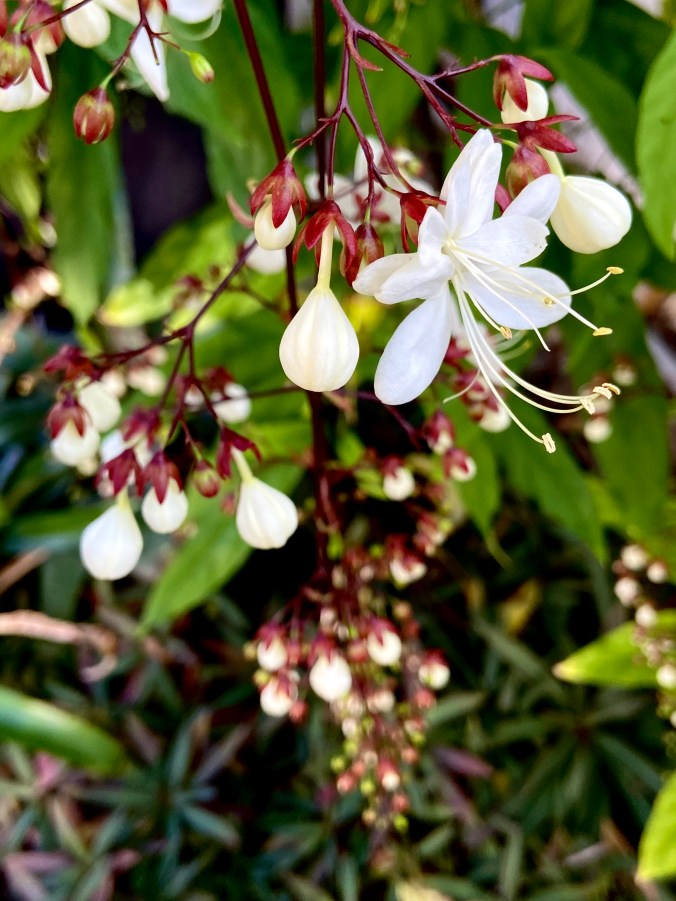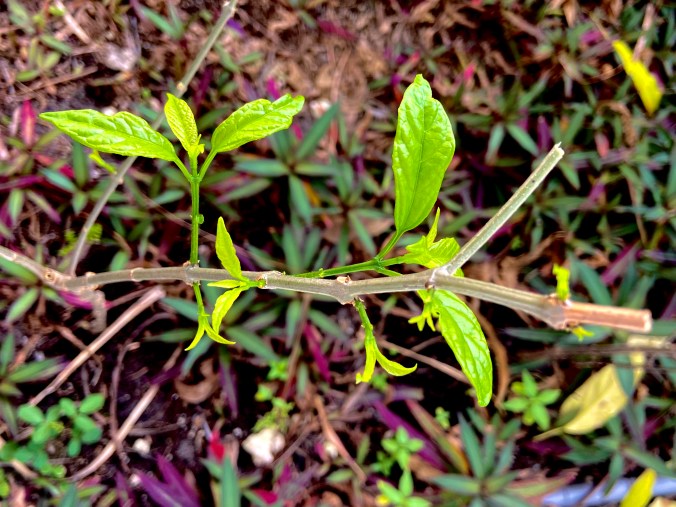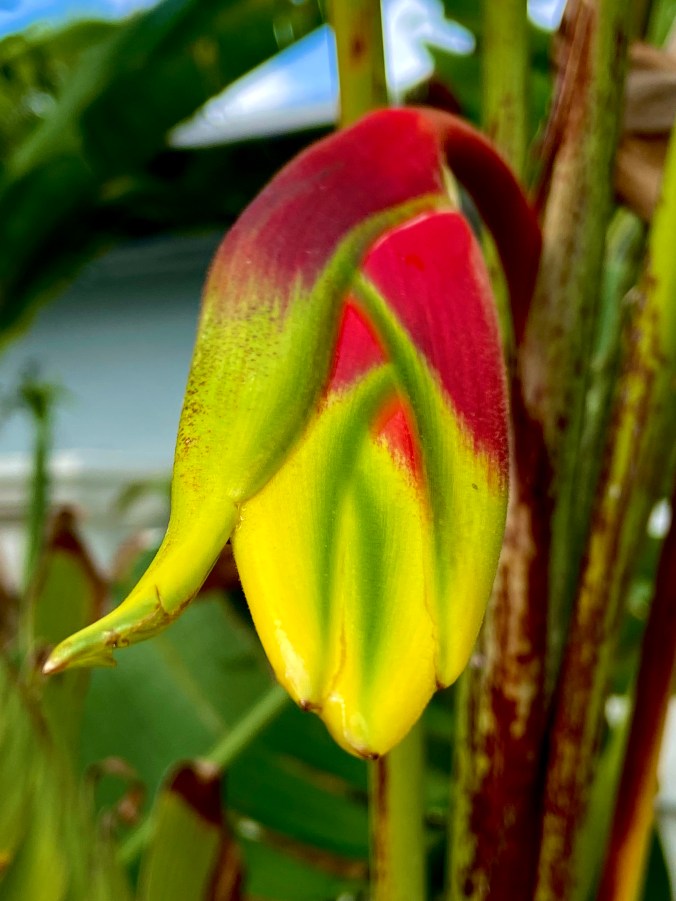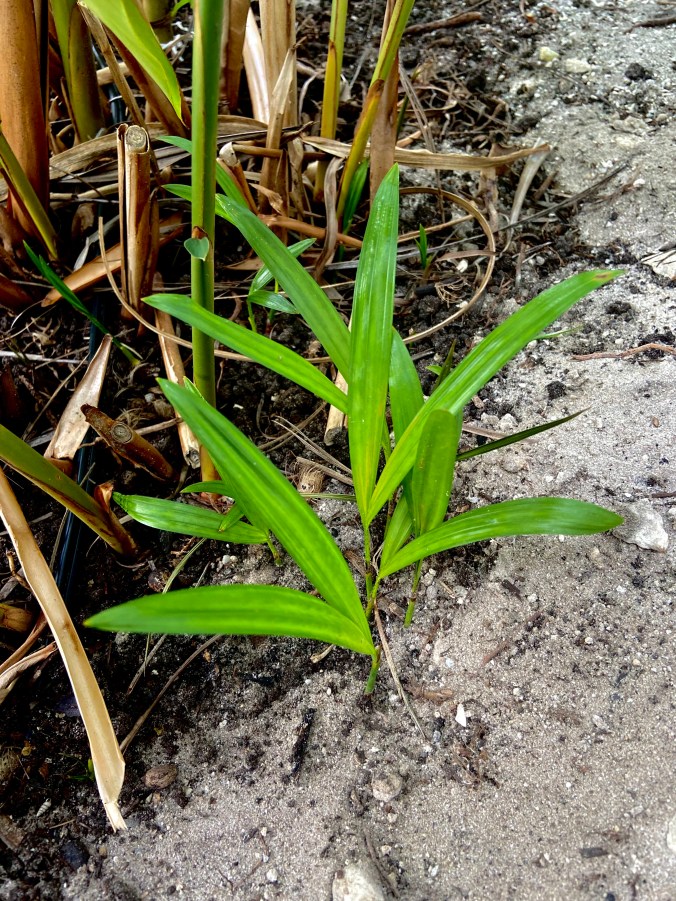As I write this, I’m sitting on the patio by the pool, enjoying one of the last cold fronts to reach all the way down the Florida peninsula. The temperature is hovering around 80 degrees and there’s a coolness on the breeze.
It’s delightful! It’s the most perfect spring day in May — make that the most perfect northern spring day in May, because this is March in Florida.
As a New York gardener, I loved spring — the buzz of glimpsing the first flush of green, eyeing new sprouts pushing up from the what’s left of winter leaves, and celebrating the return of color. I also remember the frustration, especially when the best-laid weekend garden plans were sideswiped by another of winter’s icy grasps.
As a Florida gardener, though, I have two seasons of spring-like weather, winter and spring, and I live with color all year long. An example is the bromeliad (above), which has been putting on a flower show for weeks. With this in mind, is it possible to still have spring fever in South Florida?
The answer is a simple yes.
Very often, friends and family will say they could never live in South Florida because they would miss the change of seasons. I worried about that myself when I moved to zone 10B/11. Gardeners here, though, have taught me there are changes, but one has to know where to look. So, this is where I look when I’m walking and working around my garden.
While I may not have a first flush of green — because it’s always green here — some plants manage provide that thrill. Take, for example, the lightbulb plant. Over the winter months, the lightbulb plant was covered with long, draping panicles of white flowers.
These were followed by seedpods, which I think are the happiest looking seedpods in the world.
While the seedpods ripened, the leaves on the plant turned yellow and fell from its branches. I was concerned at first, but decided to just let nature do its thing. After all, these leaves had been on the plant since last year and they must be tired. With spring’s arrival, new leaves have begun to emerge.
Traditional bulbs — like tulips and daffodils — are impossible to grow here. Although they’re sold in supermarkets and box stores, they’re best as indoor houseplants and then trashed after flowering — unless someone wants to go to the trouble of refrigerating the bulbs to trick them into winter. I once did that with hyacinths, but they petered out after two or three seasons.
A bulb that does very well here is amaryllis. Normally grown as a potted houseplant in northern areas, amaryllis is very happy to be planted outside here. This one set buds for the first time this year.
Then, in a matter of days, this happened.
In New York, there were certain plants — like forsythia — that heralded spring’s arrival. In my Florida garden, I have “lobster claw” heliconia. For much of the year, the banana-like leaves are shredded and torn by the prevailing winds. By springtime, the battered leaves look like delicate curls of aged paper.
Then, right on schedule with spring, new leaves and flowers start to emerge.
What would spring be without a little garden cleanup? Although I weed all year long — the weeds never, ever stop — the low humidity and cooler temps during this time of year make weeding a pleasure.
I’ve spent days and days pulling out sprouting areca palms, courtesy of the seeds dropped by my neighbor’s green wall of arecas. My satisfaction comes from pulling out the stem, desiccated seed, and root in one pull. If not, I run the risk of having the palm re-sprout a little bit thicker and stronger.
While crawling around on the ground pulling out arecas, I found this Jamaican croton growing beneath its parent plant. A branch had touched the ground and rooted, much like hydrangeas did in my New York garden. I removed the baby plant and gave it its own pot in my plant nursery.
Perhaps no other moment better illustrates my spring fever than the re-appearance of my transplanted coontie palm.
Coontie is not only a Florida native, but it’s also the host plant for the Attala butterfly, another Florida native (pictured above from last summer). Last year, Attala caterpillars devoured the leaves. By the end of the season, whatever remained of the plant was brown and brittle. The plant died back to the ground, something it had never done before. I was concerned.
I dug up the root ball, which actually looked like three rutabaga-sized bulbs all attached to one another. They were firm and heavy. Perhaps all was not lost. I replanted the coontie in the backyard, in a corner that I started to dedicate to native plants in an effort to learn if iguanas would avoid them. Each day I checked for any new growth… nothing.
One morning, this is what I found.
Yes, that springtime feeling surged through me, although I’m not sure if this surprise was seasonal or coincidental. Either way, I’m taking it because as a northern gardener I know that when spring stares you in the face, you embrace it.












Hurrah Kevin! You are in better spirits and your gardens inspire you.
Although my blueberries are now in full flower, we are having 20F nights in zone 7A.
The daffodils are tough as nails, and they shoulder the cold and make a splendid show every year. My house is filled with vases of them and I celebrate another spring and a March birthday.
Other spring bloomers may or may not take the freeze. Crazy winter weather past, and who knows what Mother Nature will deliver this year. I have already mowed twice, yet still await the landscape crew to prune the badly broken crape myrtle limbs from the awful ice storm I’d rather forget. And the sapsuckers have again riddled my Prague viburnums and caused many mature limbs to die.
The hellebores are splendid this time of year, as since I retired 12/31, they are not cut for sale.
I envy the fact that you have a pool. Did you ever try Wim Hof’s cold shower program? 😉 Diane
Hi Diane — and Happy Belated Birthday! Since writing this post, summer has returned to South Florida. Most plants are enjoying the humidity, but many of my orchids seem to have suffered some damage from cold snaps over the winter. By cold, I mean nighttime temps in the 40s, with windchills lower. Usually they lasted a night, but many of the flower spikes seem to have been stunted. Or… it could be a result of my own neglect. I hope winter eases up for you and so many others up north. It’s been a long haul. By the way, hellebores are one plant I regret not growing when I lived up north. As for that cold shower program… Since retiring and moving to south Florida, there’s only so much cold I can take. I even have a limit on pool water temperature. I can tolerate 82 degrees for a refreshingly brisk dip — but I much prefer 88 – 90. LOL! That being said, we have an outdoor shower that we use no matter the outside temperature — so on a windy winter day, there’s a dash to the shower, hot water, and the chilly dash back to the house — wrapped in a towel, of course. 🙂
Ah, the FL life! I remember hearing the news a few weeks back how stunned iguanas were falling from trees, stunned by the cold! What an event that must be! Splat, splat! Poor creatures.
Our new normal continues to test us. Life is becoming more and more of a challenge. I am so glad I am old and don’t have children to raise. Schools were closed here today, due to a high wind forecast! So far only warm 71F squalls. Temps were in the 20’s overnight this week too. Indeed, Mother Nature is having her way and both humans and wildlife need respite… a real, pure, memorable rest. Yes?
Be well, and I envy your outdoor shower runs! 😉
Hi Diane. If only the iguanas went splat — they make more of a thud. Each year, there’s always a story of someone mistaking the comatose iguana for dead, scooping up the body, and placing it in a garbage can or driven to a dumpster (because no one wants that smell in their own garbage can). With a little bit of heat — like inside of car — the iguana rouses and isn’t too happy about what’s happening to it. As I write this response, the high wind advisory — which we’ve had for days — is lifted, the sun is shining, we haven’t had rain for weeks, daytime temps are near 90 and evening temps are in the high 70s. In a matter of weeks, it will be rainy season and tropical. It’s a brave new world, indeed.
What a lovely post! I think the spirit of Spring is certainly around and within you.
Hello Mario. I’m so glad you liked it. As I said in the post, I’m grabbing it… these days, that’s especially important. Hope you are doing well!
Thank you for the pictures!! In Zone 3A, we have more ice and snow on the way…😭
Hi Laura. I remember when I lived in zone 6/7, I would live for the March weekends to start working in the yard — and then be thrown into a horrible mood when the weather wouldn’t cooperate. Friends who live there are having a frustrating time of it. I can’t imagine what it’s like in zone 3A. Hang in there… I hope winter eases up for you.
What an interesting post. I’ve just learned, that you DO have spring. Or sort of.
I’m one of those people who’s glad I don’t live so far south that it’s summer all year round. (And who doesn’t understand how you can thrive on it.) Here in Denmark, we’re having the loveliest early spring now, with everything springing out – and a touch of snow this morning. Love it.
But I must say you show some wonderful photos, and the happy seedpots MIGHT even make me move 😉
Lisbeth
Hello Lisbeths. Denmark in spring sounds magical! I think the hardest thing about moving so far south is adjusting your mind to the changes. It’s spring… it’s just not the same spring. The greatest challenge is yet to come, as we move toward summer. Before the equinox, South Florida will already be experiencing temperatures above your summer temperatures — then that gets combined with humidity. This area of the US is a lot like living on a tropical island. So, we adapt — yard work is finished by 11 am and then re-started after 5 pm — and a siesta in between. Air conditioning helps. 🙂
Lots of gorgeousness surrounds you. The Attala butterfly has lovely coloring. I have some amaryllis bulbs to plant outdoors. They do survive here in NC. My sisters’ put on quite a display, but mine don’t put on much of a show. Happy Spring!
Hi PBM. The Attala butterfly was brought back from near extinction because home gardeners and municipalities embraced coontie palms in gardens and medians. I’m hoping the amaryllis bulbs I have planted will start to multiply so I can have swaths of them. Fingers crossed for that one. Enjoy spring!
Your photos are absolutely beautiful, Kevin, so I know your garden must be exquisite. And in March! I understand the subtleties of seasonal change that you experience, as that describes Southern California. Our seasonal shifts aren’t very dramatic, but the plants have their own cycles, regardless of climate. Although most of my garden plants didn’t die back, there is winter dormancy, and now they’re putting out new growth and I am doing some of the same garden chores you’re doing, dividing and replanting.
I do envy you your beautiful tropical plants. They are so vibrant and stunning! I’ve tried bromeliads and they don’t die, but they also don’t thrive! We are just too dry. Your happy seedpods are a joy! LOL!
Hi Debra! One of my bucket list items is to visit a desert while its flowering. From photos I’ve seen, it looks stunning. I do miss some of my northern gardening must haves — hyacinths, tulips, hydrangeas. These are sold here as potted houseplants, but the bulbs don’t stand a chance here and the hydrangeas tend to wither away. As much as I love them, I feel it’s a waste to purchase and toss — but I do love seeing them in the stores, as least. April is our driest month, and it’s holding true this year. I believe we have a deficit right now — but in a few weeks, rainy season — and then hurricane season — are scheduled to make a return. My only hope is that climate change doesn’t make us a bullseye. I hope you and yours are doing well.
It is a challenge everywhere, I think. We are headed into severe water rationing and I am just so sad about it. If it becomes as bad as we are being warned, I really don’t know what I’m going to do. I may end up with a cactus garden after all. Not my first choice, but we’ll see! I agree with you about not purchasing plants you know aren’t going to make it longterm. I’m not sure I would know how to handle hurricane season, so when I get very envious of all your rain I try to remember that! 🙂